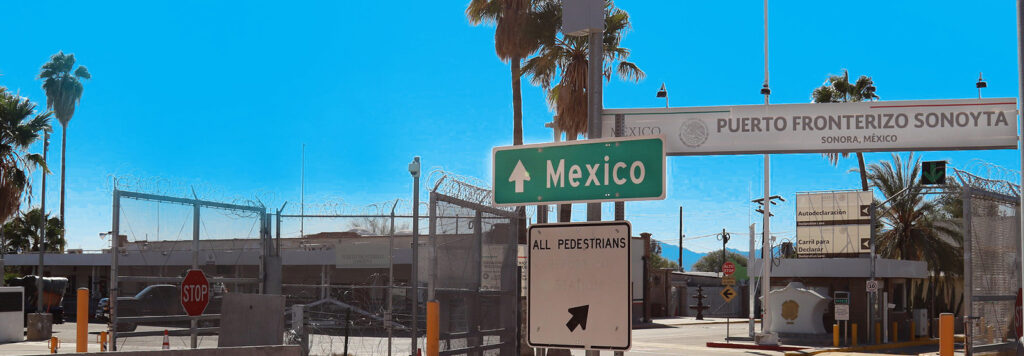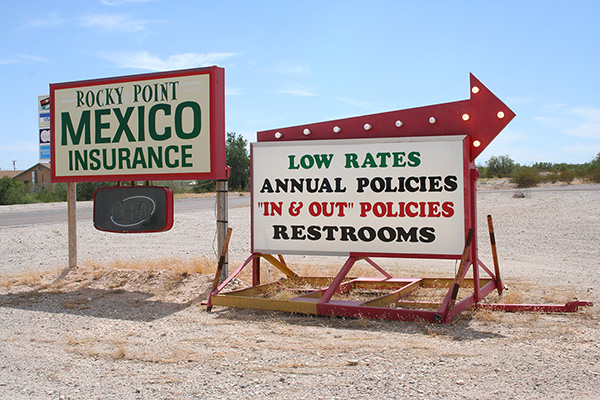
After crossing the Mexico border at Lukeville for the past 30 years on our way to Puerto Peñasco, there are a few must haves that we’ve learned for certain. Anything I was not sure about, I did a little research and put it together for you here. Whether or not you are asked about these things when crossing the border may depend on whether you get a Red Light or a Green Light. But either way, even if you are not asked, it’s important to know that you should still be prepared.
When crossing the border into Mexico by car, there are a few things you absolutely must have. You must have a current passport, Mexican auto insurance, current auto registration, up to date health certification for any pets, and no prohibited items. If you plan to travel beyond the Sonoran Free Zone, you will need additional permits as well.
Before explaining the legalities of why you need these, a quick explanation of Red Light / Green Light for those who have never experienced this Customs process is important. This is true because, let’s face it, if you’ve driven into Mexico, in the southwest at least, you know that the likelihood of getting caught without any of these required documents it pretty much solely dependent on drawing a RED LIGHT.
So What Does The Red Light Mean?
When you travel to Mexico by plane you get to to press a button connected to a random light which is used to decide if you get inspected or not. This is similar when you drive your car into Mexico. You are stopped in the entry lane and a lightbox lights up for your vehicle. That light will be Red or Green.
If it is green, you are permitted to “go” or pass without having to answer any questions or have your vehicle inspected.
If that light is red, you are waved to the left to a parking space where Mexican border agents who works for Aduana (Customs) and SAGARPA (Secretary of Agriculture, Ranching, Rural Development, Fishing and Feed) will ask you to open your doors or trunk to browse through your cargo for prohibited items. They may also ask you a few questions about your trip. It’s a quick experience if you have done your research and made sure you have not brought any banned items across the border.
At the Lukeville-Sonoyta border crossing on the way to Puerto Peñasco, you can be pulled over a second time to be inspected by Mexican military officials. For this inspection, you may be asked to step your of your car while they inspect the vehicle. (I was allowed to keep my purse with me.) Again, this inspection is quick.
If you are stopped at either check point, be polite, helpful and respectful. Most agents speak enough English to explain everything. Your cooperation helps the process move along more quickly.
Now that we understand the draw of luck of the Red light Green light, lets explain the five things you must have when driving across the Mexico border.
You Need A Valid Passport
They may not ask for it. You may never have to show it. You might even be able to cross back into the U.S. without it.
For in depth specifics on passport requirements, check out my post
Do I REALLY Need a Passport To Go To Rocky Point Mexico?
But as a visiting guest to Mexico, the Mexico Secretary of Exterior Relations requires U.S. and Canadian citizens to have a valid passport to enter. A passport includes a passport book or the Passport Card which is designed for frequent travelers to Mexico by land and sea.
If you are traveling to Rocky Point, you probably won’t need a tourist visa if your stay is less than 180 days. You won’t need a vehicle permit as long as you stay within the Sonoran Free Zone. For example, Puerto Peñasco is located in the Sonoran Free Zone. See MAP.
You Need Mexican Auto Insurance

If you are taking a car, don’t get caught without Mexican auto insurance. Your U.S. auto insurance WILL NOT cover you for liability in Mexico. And Mexico requires Mexican Domiciled auto liability insurance.
I spent 10 years as an Arizona insurance broker and have always been a frequent Peurto Peñasco visitor. These are facts I made sure I understood for my family and my insurance customers. US automobile liability, and most collision and comprehensive, insurance coverage is not valid in Mexico. If you are not sure, call your agent or read your policy. As an agent, I only had one insurance company offer any coverage in Mexico and it was comprehensive only (damage to your own car) and it only covered you for 35 miles across the border. (Rocky Point is 62 miles from the border.)
If you are towing a trailer of any type, be sure it is also covered on your Mexican insurance policy.
A final note on Mexican Auto Insurance, the U.S. State Department strongly recommends you purchase a full coverage insurance policy that will cover the cost of bail and legal services. If police are not able to determine who is at fault at the scene, it is said that both drives can be detained until fault is determined.
Mexican auto insurance can be purchased online before you go or at various locations on your way to the border. We always work with Amanda at Select Choice Insurance in Phoenix. It’s super easy to buy a policy online HERE.
Tip: Buying a policy for the weekend is pretty inexpensive. We have found that if you travel more than 4-5 times a year, it may be worth looking into a 6 month or 12 month policy. The fees for an single policy add up when you buy 4-5 short trip policies. We found it to be cheaper to buy the longer term policy. However, we do travel to our second home in Rocky Point a lot.
You Need Current Auto Registration
On rare occasion, you may be asked to show your auto registration. It usually only happens to us when we get a red light to be inspected and then the Mexican border agents ask to see our registration about a third of the time.
The Mexican border agents review your registration they usually ask to see identification for proof of ownership. The reason for this is that “Mexican law requires that only owners drive their vehicles or that the owner be inside the vehicle.”
Your registration should be current. If your registration is not current, you could be turned back to the U.S. This has happened to some of our friends.
If you are towing a trailer with ATVs, you will be asked for registration of the ATVs. Every time we take our Razor, we have been asked to show registration and identification to prove we own the Razor. This is true for travel trailers as well.
If you are driving a company vehicle with logos, they will ask to see your registration. I have not found any “official” rules on this in my search, but most informational sites state that you will need to show documented proof of a working relationship with the company on the registration. This can be a letter on company letterhead signed by a company official. We used a business card. That seemed to work, however it did say “President” for the title.
If you are driving a rental car to Rocky Point, be sure to take your rental paperwork with you. This can be used in place of registration. Be sure to let the rental car company know you are taking the vehicle to Mexico.
You will also need current registration if you have to apply for a Temporary Vehicle Permit from the Banjercito for traveling outside the Sonoran Free Zone. If you traveling outside of the Sonoran Free Zone without this permit, your car could be impounded.
You Need Current Health Certificates For Your Pets
If you are traveling with your family dog or cat, you will absolutely need a current Mexican approved health certificate and up to date vaccinations.
Keep in mind that only dogs and cats are considered pets. Birds and boas should be left at home.
We take our dogs to Rocky Point so we take this requirement pretty seriously. I cover, in detail, what you need to know about traveling with your pets in this post 5 Things You Need When Taking Your Dog to Rocky Point
You Need to Leave Prohibited Items at Home
Again getting caught with prohibited items could only be a matter of Red Light / Green Light but that doesn’t mean one should roll the dice. Some of the penalties are very steep.
Food
Certain foods are banned from being brought into Mexico for various reasons. Some foods may contain ingredients Mexico considers unsafe. Some fruits and vegetables can contain invasive species hidden in them, for example the Mediterranean Fruit Fly that caused incredible destruction to citrus crops.
Whatever the reason, there are certain foods you are not allowed to bring into Mexico. For a more comprehensive list check out this printout from the National Health Services of Mexico (SENASICA)
List of Food Products For Tourists
This list spells out what is prohibited and it also tells you how much of certain foods you are allowed to bring. (Pay attention to what countries you are allowed to bring these items from. The U.S. is not included for most dairy products.)
Some major prohibited foods include fresh meats and cheeses, even if they are on a sandwich. Dog and cat food made from beef is also not allowed.
Guns & Ammo
Some of the biggest prohibited items that will land a person in a world of trouble when going to Mexico are weapons and drugs.
Guns and ammunition are illegal in Mexico. You WILL go to jail. Directly to jail. Without passing go. To jail. According to the U.S. Department of State
“Weapons laws in Mexico vary by state, but it is generally illegal for travelers to carry weapons of any kind including firearms, knives, daggers, brass knuckles, as well as ammunition (even used shells). Illegal firearms trafficking from the United States to Mexico is a major concern, and the Department of State warns all U.S. citizens against taking any firearm or ammunition into Mexico. If you are caught entering Mexico with firearms or ammunitions, you will likely face severe penalties, including prison time.”
A permit can be obtained from the Secretariat of National Defense, but you must apply for and receive your permit prior to entering Mexico. It is recommended to contact the Embassy of Mexico for more information on taking guns to Mexico.
Drugs & Medications
The list of drugs you can’t take to Mexico include the usual “bad guys” like opium, heroin and marijuana. Even medical marijuana.
But what you really have to pay attention to is prescriptions and over the counter meds. Mexico’s list of controlled substances differs from the U.S. list. See the list HERE.
Their list includes some common U.S. prescriptions substances which the U.S. Department of State says you could still be penalized for. It is recommended that prescription medication, you should travel with the original container and carry a copy of your prescription or a doctor’s letter.
They also point out that some inhalers and medicines considered “over the counter” in the U.S. are considered controlled substances in Mexico like codeine or pseudoephedrine which is found in decongestants and allergy medicines.
Garbage Pail Kids
That’s right! Straight from the Mexico Government:
Stamps printed in colours or in black and white, presented for sale in envelopes or packets, even when they include chewing gum, candy, or any other type of articles, containing drawings, figures, or illustrations that portray childhood in a denigrating or ridiculous manner, in attitudes which incite violence, self-destruction, or any other type of anti-social behaviour, known as “Garbage Pail Kids”, for example, printed by any company or commercial denominations.
In 1988, parents were outraged at the concept of Garbage Pail Kids. Claiming they are “Diabolic” and Degenerate.” Can’t say I disagree. …but let’s not deflect.
Green Light Go
For the most part, it’s pretty much common sense what you should and should not bring to Mexico. And to make it more convenient to travel to Rocky Point, Mexico and the state of Sonora have created the Sonoran Free Zone which removes the burden of additional paperwork and permits so we can to get to the beach and enjoy our vacation more simply and quickly.
As always, remember you are a guest in a foreign country. Be polite. Follow the rules of your host. And lastly, mind your manners and you’ll enjoy your vacation.


